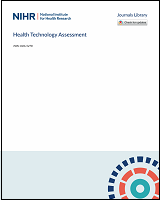NCBI Bookshelf. A service of the National Library of Medicine, National Institutes of Health.
Poolman M, Roberts J, Wright S, et al. Carer administration of as-needed subcutaneous medication for breakthrough symptoms in people dying at home: the CARiAD feasibility RCT. Southampton (UK): NIHR Journals Library; 2020 May. (Health Technology Assessment, No. 24.25.)

Carer administration of as-needed subcutaneous medication for breakthrough symptoms in people dying at home: the CARiAD feasibility RCT.
Show detailsQualities of potential future outcome measures under investigation in CARiAD
TABLE 27
Qualities of potential future outcome measures under investigation in CARiAD
| Outcome measure | Description | Method(s) of assessment |
|---|---|---|
| Family MSAS-GDI |
|
|
| QOLLTI-F |
|
|
| Time to symptom relief | This measure will be calculated using data items from the carer diary. We will minimise bias by using strict definitions of episode timings:
|
|
Rationale for choice of Family MSAS-GDI and QOLLTI-F
The Memorial Symptom Assessment Scale (32 items) is a valid and reliable patient self-report instrument.10 The MSAS-GDI has demonstrated reliability and validity in measuring global symptom distress from the patient perspective. Although the scale was designed to produce one single score, the individual items can also be used as single item indicators of burdensome symptoms at the end of life, identifying which symptoms are getting better or worse over time in different patient populations.59
Hickman et al.59 showed that the MSAS-GDI is amenable to modification for use in research with recently bereaved family respondents whose family members died from a wide range of causes. Items were modified so that the questions focused on the symptoms experienced by decedents in the last week of their life, as observed by family respondents. The Family MSAS-GDI has good face validity for use in understanding symptoms experienced by patients in the last week of life, regardless of cause of death or role in relation to the patient (carer or HCP).61
In the Hickman et al.59 study, in the 103 family members the mean Family MSAS-GDI score was 1.14 (SD 0.87), with a range from 0 to 3.73. The scale demonstrated good internal consistency (α = 0.82). The average item-total correlation was r = 0.49 and the average inter-item correlation was r = 0.30, which suggests that items were moderately correlated with the overall total scale and with each other. They concluded that the Family MSAS-GDI could prove to be a useful tool in assessing and tracking global symptom distress in dying patients.59
Lobchuk’s work60 corroborates these findings, showing good to excellent intraclass correlations with patients’ ordinal ratings to support the concurrent validity and utility of the MSAS-GDI subscales in family carer populations who care for cancer patients in the home setting.
Rationale for the choice of QOLLTI-F41 is that it has established psychometric properties (reported validity and reliability, demonstrated responsiveness, no floor and ceiling effects), is relatively brief (16 items) and can be administered every 2 days (rather than daily, reducing the risk of overburdening carers). It is broadly aimed at carer quality of life, and incorporates issues of control (reported as paramount by carers) and self-efficacy (conceptualised as ‘a person’s belief about her or his ability to organise and execute courses of action to manage given situations’).
- Outcome measures under contention for a future definitive trial - Carer administ...Outcome measures under contention for a future definitive trial - Carer administration of as-needed subcutaneous medication for breakthrough symptoms in people dying at home: the CARiAD feasibility RCT
- Plain English summary - Sexual health promotion in people with severe mental ill...Plain English summary - Sexual health promotion in people with severe mental illness: the RESPECT feasibility RCT
- Achenbach Child Behaviour Checklist - Sixteen-week versus standard eight-week pr...Achenbach Child Behaviour Checklist - Sixteen-week versus standard eight-week prednisolone therapy for childhood nephrotic syndrome: the PREDNOS RCT
- Additional meta-analysis results - Coenzyme Q10 to manage chronic heart failure ...Additional meta-analysis results - Coenzyme Q10 to manage chronic heart failure with a reduced ejection fraction: a systematic review and economic evaluation
- Acknowledgements - Carer administration of as-needed subcutaneous medication for...Acknowledgements - Carer administration of as-needed subcutaneous medication for breakthrough symptoms in people dying at home: the CARiAD feasibility RCT
Your browsing activity is empty.
Activity recording is turned off.
See more...